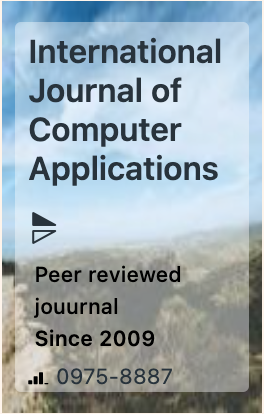The week's pick
Random Articles
Reseach Article
Decoding Sentiment: How Machine Learning Maps Emotions Across Domains
| International Journal of Computer Applications |
| Foundation of Computer Science (FCS), NY, USA |
| Volume 186 - Number 60 |
| Year of Publication: 2025 |
| Authors: Dilasha Shakya, Rushit Dave, Dishant Thakkar |
 10.5120/ijca2025924352
10.5120/ijca2025924352
|
Dilasha Shakya, Rushit Dave, Dishant Thakkar . Decoding Sentiment: How Machine Learning Maps Emotions Across Domains. International Journal of Computer Applications. 186, 60 ( Jan 2025), 22-28. DOI=10.5120/ijca2025924352
Abstract
The internet has become a useful platform for individuals to share their experiences, emotions and gather information. Whether it is getting a good coffee among a variety of options or searching for the ideal restaurant for dinner, people enjoy listening to other users' experiences and opinions before deciding to go there. Aside from personal uses, this digital space has become an excellent tool for businesses, politicians, health care sector and activists to understand their audience, take their feedback and take actions accordingly. It has also become an essential outlet for individuals to express their thoughts, share videos, and advocate against injustice, amplifying their voices in the pursuit of justice. Another usage of this might be in the areas like market research, political analysis, stock trends, and others, which will be further explored in the paper. Sentiment analysis serves this purpose by utilizing machine learning techniques and natural language processing to identify emotions from textual data. The first stage is preprocessing of data. This involves removal of unnecessary words, punctuation, repeats, standardization of words and correction of spelling errors from unstructured data. Crucial features and adjectives are then extracted to determine their polarity. Various research uses different methods for calculating overall polarity. Rule-based approaches assign predefined scores to words and their synonyms, while others rely on sentence structure, word frequency, and intensity. Feature extraction methods include bag of words, word embedding, word count and noun count. These extracted features are then classified into machine learning models which help with analysis and prediction processes. The measure of performance is then evaluated using precision, recall, accuracy along with tools such as confusion and classification matrix. Overall, sentimental analysis has emerged as a significantly growing area in recent years with great potential across various fields such as business, politics, healthcare, social media, fashion, crisis management, tourism. Therefore, proper research and increased model performance in sentiment analysis systems ensures the model can provide accurate insights aiding in better decision-making and planning across a wide range of applications.
References
- Singh, J., Singh, G., & Singh, R. (2017). Optimization of sentiment analysis using machine learning classifiers. Human-centric Computing and Information Sciences, 7, Article 32. https://doi.org/10.1186/s13673-017-0116-3
- Hasan, A., Moin, S., Karim, A., & Shamshirband, S. (2018). Machine learning-based sentiment analysis for Twitter accounts. Mathematical and Computational Applications, 23(1), Article 11. https://doi.org/10.3390/mca23010011
- Dave, K., Lawrence, S., & Pennock, D. M. (2003). Mining the peanut gallery: Opinion extraction and semantic classification of product reviews. In Proceedings of the 12th International Conference on the World Wide Web (pp. 519–528). ACM Press. https://doi.org/10.1145/775152.775226
- Flores-Ruiz, D., Elizondo-Salto, A., & Barroso-González, M. d. l. O. (2021). Using social media in tourist sentiment analysis: A case study of Andalusia during the COVID-19 pandemic. Sustainability, 13(7), 3836. https://doi.org/10.3390/su13073836
- Coşkun, M., & Ozturan, M. (2018). europehappinessmap: A framework for multi-lingual sentiment analysis via social media big data (A Twitter case study). Information, 9(5), 102. https://doi.org/10.3390/info9050102
- Nasim, Z., Rajput, Q., & Haider, S. (2017). Sentiment analysis of student feedback using machine learning and lexicon-based approaches. International Journal of Computer Applications, 161(6), 1–5. https://doi.org/10.5120/ijca2017913229
- Ott, M., Cardie, C., & Hancock, J. T. (2013). Negative deceptive opinion spam. In Proceedings of the 2013 Conference of the North American Chapter of the Association for Computational Linguistics: Human Language Technologies (pp. 497–501). Association for Computational Linguistics. https://aclanthology.org/N13-1053
- Cui, H., Mittal, V., & Datar, M. (2006). Comparative experiments on sentiment classification for online product reviews. In Proceedings of the 21st National Conference on Artificial Intelligence (pp. 1265–1270). AAAI Press.https://www.aaai.org/Papers/AAAI/2006/AAAI06-202.pdf
- Lu, Y., & Zheng, Q. (2021). Twitter public sentiment dynamics on cruise tourism during the COVID-19 pandemic. Current Issues in Tourism, 24(7), 892–898. https://doi.org/10.1080/13683500.2021.1889480
- Pak, A., & Paroubek, P. (2010). Twitter as a corpus for sentiment analysis and opinion mining. In Proceedings of the Seventh International Conference on Language Resources and Evaluation (pp. 1320–1326). European Language Resources Association. http://www.lrec-conf.org/proceedings/lrec2010/pdf/385_Paper.pdf
- Rain, C. (2013). Sentiment analysis in Amazon reviews using probabilistic machine learning. Swarthmore College. https://www.swarthmore.edu/sites/default/files/assets/documents/engineering/CS97_2013_Rain.pdf
- Gautam, G., & Yadav, D. (2014). Sentiment analysis of Twitter data using machine learning approaches and semantic analysis. In 2014 Seventh International Conference on Contemporary Computing (IC3) (pp. 437–442). IEEE. https://doi.org/10.1109/IC3.2014.6897213
- Jain, A. P., & Dandannavar, P. (2016). Application of machine learning techniques to sentiment analysis. In 2016 2nd International Conference on Applied and Theoretical Computing and Communication Technology (iCATccT) (pp. 628–632). IEEE. https://doi.org/10.1109/ICATCCT.2016.7912109
- Srinivasan, R., & Subalalitha, C. N. (2023). Sentimental analysis from imbalanced code-mixed data using machine learning approaches. Distributed and Parallel Databases, 41, 37–52. https://doi.org/10.1007/s10619-021-07331-4
- Han, K.-X., Chien, W., Chiu, C.-C., & Cheng, Y.-T. (2020). Application of support vector machine (SVM) in the sentiment analysis of Twitter dataset. Applied Sciences, 10(3), 1125. https://doi.org/10.3390/app10031125
- Leelawat, N., Jariyapongpaiboon, S., Promjun, A., Boonyarak, S., Saengtabtim, K., Laosunthara, A., Yudha, A. K., & Tang, J. (2022). Twitter data sentiment analysis of tourism in Thailand during the COVID-19 pandemic using machine learning. Heliyon, 8(1), e08795. https://doi.org/10.1016/j.heliyona.2022.e08795
- Pungliya, V., Raut, A., Bhonsle, R., Purohit, A., Patel, A., & Shashidhar, R. (2022). Movie recommendation and sentiment analysis using machine learning. Global Transitions Proceedings, 3, 279–284. https://doi.org/10.1016/j.gltp.2022.01.017
- Jabbar, J., Urooj, I., JunSheng, W., & Azeem, N. (2019). Real-time sentiment analysis on e-commerce applications. In 2019 IEEE 16th International Conference on Networking, Sensing and Control (ICNSC) (pp. 391–396). IEEE. https://doi.org/10.1109/ICNSC.2019.8743331
- Nandwani, P., & Verma, R. (2021). A review on sentiment analysis and emotion detection from text. Social Network Analysis and Mining, 11, Article 81. https://doi.org/10.1007/s13278-021-00776-6
- Khanchi, I., Ahmed, E., & Sharma, H. K. (2020). Automated framework for real-time sentiment analysis. In Proceedings of the 5th International Conference on Next Generation Computing Technologies (NGCT-2019). SSRN. https://doi.org/10.2139/ssrn.3702238
- Taj, S., Shaikh, B. B., & Meghji, A. F. (2019). Sentiment analysis of news articles: A lexicon-based approach. In 2019 2nd International Conference on Computing Mathematics and Engineering Technologies (iCoMET) (pp. 1–5). https://doi.org/10.1109/ICOMET.2019.8673428
- Cortes, C., & Vapnik, V. (1995). Support-vector networks. Machine Learning, 20, 273–297. https://doi.org/10.1007/BF00994018
- Mubarok, M. S., & Adiwijaya, A. (2017). Aspect-based sentiment analysis to review products using Naïve Bayes. In AIP Conference Proceedings (Vol. 1867, No. 1, p. 020060). AIP Publishing. https://doi.org/10.1063/1.4994463
- El Mrabti, S., Al Achhab, M., & Lazaar, M. (2018). Comparison of feature selection methods for sentiment analysis. In Tabii, Y., Lazaar, M., Al Achhab, M., & Enneya, N. (Eds.), Big Data, Cloud and Applications. BDCA 2018, Communications in Computer and Information Science (Vol. 872). https://doi.org/10.1007/978-3-319-96292-4_21
- Yi, S., & Liu, X. (2020). Machine learning-based customer sentiment analysis for recommending shoppers, shops based on customers’ reviews. Complex & Intelligent Systems, 6, 621–634. https://doi.org/10.1007/s40747-020-00147-2.
- Lai, S. T., & Mafas, R. (2022). Sentiment analysis in healthcare: Motives, challenges & opportunities pertaining to machine learning. In 2022 IEEE International Conference on Distributed Computing and Electrical Circuits and Electronics (ICDCECE) (pp. 1–4). https://doi.org/10.1109/ICDCECE53908.2022.9792766.
- Dangi, D., Dixit, D. K., & Bhagat, A. (2022). Sentiment analysis of COVID-19 social media data through machine learning. Multimedia Tools and Applications, 81(29), 42261–42283.
Index Terms
Keywords

